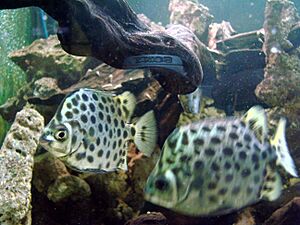Spotted scat facts for kids
Quick facts for kids Spotted scat |
|
|---|---|
 |
|
| Conservation status | |
| Scientific classification | |
| Synonyms | |
|
The spotted scat is a fascinating fish known by many names, like butterfish or tiger scat. Its scientific name is Scatophagus argus. This fish comes in two main color types: the green scat and the ruby or red scat. You can find these fish in the warm waters of the Indo-Pacific region, from Japan all the way to New Guinea and southeastern Australia. They love living in muddy coastal areas, including places like river mouths, mangrove forests, and harbors. Spotted scats are also popular fish for home aquariums.
Contents
What's in a Name?
The spotted scat was first officially described in 1766 by a famous scientist named Carl Linnaeus. He gave it the name Chaetodon argus. Later, in 1831, another scientist, Georges Cuvier, created the fish genus Scatophagus. Linnaeus's C. argus then became the main example for this new group.
The name argus comes from an old Greek story. Argus was a giant with a hundred eyes who guarded a princess named Io. After he died, his eyes were said to have become the spots on a peacock's feathers. This name was chosen for the fish because of the many brown or reddish-brown spots that cover its body, making it look like it has many eyes!
Appearance and Features
The spotted scat has a body that looks like a rectangle and is quite flat from side to side. Its head has a steep slope on top. It has fairly large eyes, but they are smaller than its rounded snout. The fish has a small mouth that is horizontal and cannot be pushed out. Inside its jaws, there are several rows of small, brush-like teeth.
The fin on its back, called the dorsal fin, has 10 to 11 sharp spines and 16 to 18 soft rays. The fin on its belly, the anal fin, has 4 spines and 13 to 15 soft rays. There's a deep dip between the spines and soft rays of the dorsal fin. The back edges of the soft parts of the dorsal and anal fins are mostly straight up and down.
Young spotted scats have a rounded tail fin, but as they grow up, their tail fin becomes flatter or slightly notched. Their body is covered in small, rough scales. The fish's body color can be greenish-brown or silvery, with many brown to red-brown spots. Young fish are greenish-brown with either a few large, dark, round spots or five to six dark stripes going up and down their body. These fish can grow up to about 38 centimeters (15 inches) long.
Where They Live
The spotted scat lives in a very wide area across the Indo-Pacific region. You can find them from the Persian Gulf all along the coast of South Asia and into the western Pacific Ocean. They live as far north as Japan and as far south as New South Wales in Australia, New Caledonia, and Fiji. They have even been seen in French Polynesia.
A small group of these fish might have started living in the Mediterranean Sea near Malta. This probably happened because some aquarium fish were released into the wild. These fish prefer calm, shallow coastal waters. They are often found in places like river mouths, harbors, mangrove swamps, and the lower parts of freshwater rivers, especially where the water has a lot of minerals. When they are very young, they float right on the surface of the water.
Life and Habits
The spotted scat is an omnivorous eater, meaning it eats both plants and animals. It's not picky about its food! In 1992, scientists found that adult scats in the Philippines mostly ate plants, while younger scats preferred tiny water animals called zooplankton. The name Scatophagus means "dung eater," but this might be a mistake. Scientists haven't actually seen them eating waste.
Spotted scats can live in different types of water, from salty ocean water to freshwater rivers. This means they can handle different levels of saltiness. When they are very young, they live in freshwater. But as they get older, they move to saltwater environments. They need warm water, between 21 and 28 degrees Celsius (70 to 82 degrees Fahrenheit), so they don't live in cold waters. These fish often swim together in groups, called schools.
Reproduction and Life Cycle
Female spotted scats are ready to have babies when they are about 7 to 9 months old and weigh around 150 grams (5.3 ounces). Males become ready to reproduce when they are a bit smaller. In the Philippines, the fish start to spawn (lay eggs) when the monsoon rains begin in June and July. The increased rain brings cooler temperatures, more water flowing out of rivers, and less salty water.
The eggs are very tiny, about 0.7 millimeters (0.03 inches) across. They are clear and round. The baby fish, called larvae, hatch from the eggs in about 20 hours after fertilization. When they hatch, they are only about 1.8 millimeters (0.07 inches) long! Young scats go through a special floating larval stage, similar to butterflyfishes.
How People Use Them
People in the areas where spotted scats live sometimes catch and eat them. Be careful though! The fish has small spikes on its front fins that can sting. The sting can cause a lot of pain and make you feel dizzy. If someone gets stung, soaking the area in hot water can help. Spotted scats are also popular fish for people who keep aquariums.
Images for kids



